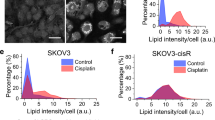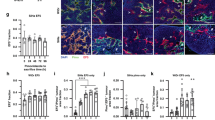Abstract
The novel fluorinated 2-nitroimidazole SR-4554 is undergoing preclinical development as a magnetic resonance spectroscopy and imaging probe for hypoxic tumour cells. We have used electron energy loss spectroscopic analysis (EELS) to show selective reduction and differential subcellular localisation of SR-4554 in human ovarian multicellular spheroids. SR-4554 was demonstrated to be metabolised by these A2780 cells under hypoxic but not under normal aerobic cell culture conditions. The EELS technique illustrated that the relative amount of drug within the cytoplasm of cells from both the inner region (150-160 microns from edge) and outer edge of the spheroid did not differ significantly after an initial 3 h incubation with drug. In contrast, an 8-fold differential between the amount of drug retained in the cytoplasm (primarily ribosomes and endoplasmic reticulum) of cells from the inner vs outer regions of the spheroids was observed following a subsequent 2 h 'chase' culture in drug-free medium. Within cells from the hypoxic region of the spheroid, SR-4554 was mainly associated with the endoplasmic reticulum, nucleus and the cytoplasmic side of intracellular vesicles and also to a lesser extent with the nuclear periphery. Interestingly, the drug was only weakly associated with the mitochondria and plasma membrane of the cells. The characteristics of cellular and subcellular distribution of SR-4554 are consistent with the hypothesis that 2-nitroimidazole compounds undergo hypoxia-mediated enzymatic reduction to reactive species. These reactive species are selectively retained in the cells in which they are metabolised through covalent association with subcellular components. These findings provide additional support for the clinical development of the drug as a non-invasive probe for tumour hypoxia and at the same time illustrate the utility of the EELS technique for examining the heterogeneity of drug distribution both between and within cells.
This is a preview of subscription content, access via your institution
Access options
Subscribe to this journal
Receive 24 print issues and online access
$259.00 per year
only $10.79 per issue
Buy this article
- Purchase on Springer Link
- Instant access to full article PDF
Prices may be subject to local taxes which are calculated during checkout
Similar content being viewed by others
Author information
Authors and Affiliations
Rights and permissions
About this article
Cite this article
Aboagye, E., Lewis, A., Johnson, A. et al. The novel fluorinated 2-nitroimidazole hypoxia probe SR-4554: reductive metabolism and semiquantitative localisation in human ovarian cancer multicellular spheroids as measured by electron energy loss spectroscopic analysis. Br J Cancer 72, 312–318 (1995). https://doi.org/10.1038/bjc.1995.330
Issue Date:
DOI: https://doi.org/10.1038/bjc.1995.330
This article is cited by
-
A phase I study of the nitroimidazole hypoxia marker SR4554 using 19F magnetic resonance spectroscopy
British Journal of Cancer (2009)
-
A novel hypoxia-dependent 2-nitroimidazole KIN-841 inhibits tumour-specific angiogenesis by blocking production of angiogenic factors
British Journal of Cancer (2003)



